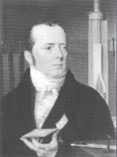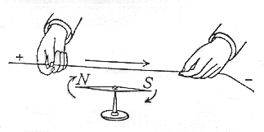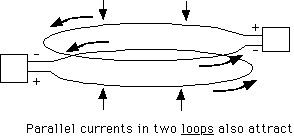(E19) Electro-Magnetism
Magnetic poles and electric charges at one time seemed rather similar: in each case, two kinds existed, opposites attracted and likes repelled. As Coulomb found around 1777, the forces between charges or poles always diminished with distance r like 1/r2, which was also the way gravity decreased. Yet there were differences. Magnetic poles always came in matched pairs, and steel needles could be magnetized by stroking them repeatedly in one direction by the pole of another magnet, or a natural "lodestone" magnet. Soft iron (like the kind used in paperclips, baling wire and coat hangers) also became magnetized when touched by a magnet, but this magnetization was temporary and ended when the magnet was removed.
The Earth itself was a giant magnet. This "geomagnetism" was a boon to sailors in mid-ocean, but magnetic north differed by a few degrees from astronomical north, and its direction slowly shifted over the decades. Edmond Halley--remembered for his comet--came up with an ingenious explanation of that slow variation: Earth consisted of layers, spheres within spheres, each magnetized differently and rotating slightly differently (it turned out to be more complicated than that).
Then around 1800 Alessandro Volta invented the electric battery, and scientists in many countries began studying its electric currents. One was a Danish scholar, Hans Christian Oersted, professor of science in Copenhagen and personal friend of Hans Christian Anderson, spinner of folk tales, including "the ugly duckling" and "the little mermaid". One evening he invited a group of friends to his home, to perform for them some science demonstrations (more than one version of the story exists). With his "voltaic pile" he drove an electric current through a metal wire, showing that it heated up. On the same table, for another demonstration, he had a magnetic compass, and to his surprise he noted that every time the battery was connected, the magnetic needle rotated to a different position, returning to its north-south orientation when the current stopped. He did not point it out to his visitors, but after they left, he satisfied himself that the effect was real.
Yet he was unable to understand it. The needle was neither attracted to the wire nor repelled by it, but rotated, trying to point perpendicular to it. The rotation was in one direction with the needle above the wire, in the opposite direction below it, and reversing the battery connections also reversed the rotation. After experimenting for several months without reaching an explanation, he published a written report (in Latin!) in the science journals of his day, inviting other researches to confirm it and maybe puzzle it out. The magnetic force could certainly be made stronger by winding the wire in a coil, which acted like a bar magnet. The magnetic effect was amplified even more if an iron rod was inserted in the coil (creating an "electromagnet") but even without any iron, the coil acted like a magnet, just not as strongly. Two coils lined up along the same axis attracted each other when the currents circulated in the same direction and repelled if the directions were reversed.
Andre-Marie Ampére in France felt that if a current in a wire exerted a magnetic force on a compass needle, two such wires also should interact magnetically. In a series of ingenious experiments he showed that this interaction was simple and fundamental--parallel (straight) currents attract, anti-parallel currents repel. The force between two long straight parallel currents was inversely proportional to the distance between them and proportional to the intensity of the current flowing in each.
(it gets further complicated if the currents flow in directions inclined to each other by some angle). To find then the force between wires of complicated shape that carry electrical currents, all these little bitty contributions to the force must be added up, which requires integral calculus. For two straight wires, the final result is as above--a force inversely proportional to 1/R, not to 1/R2. This basic formula will be later revisited] Here is how this can lead to the notion of magnetic poles. Bend the wires into circles with constant separation (figure below):
--Two circular currents in the same direction attract each other. The magnetic property becomes even stronger if a core of iron is placed inside the coils, creating an "electromagnet"; that requires enlisting the help of iron, but is not essential. |



